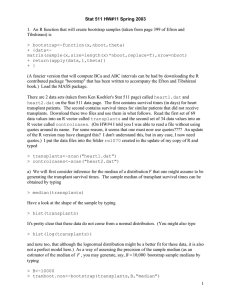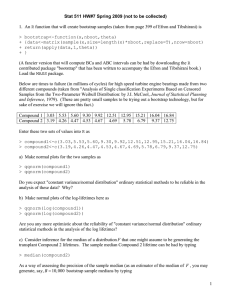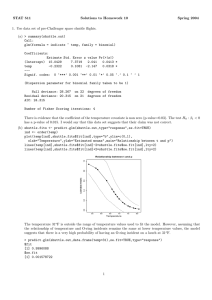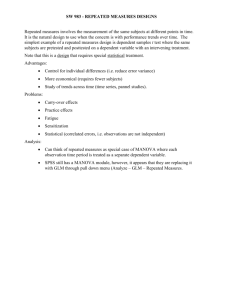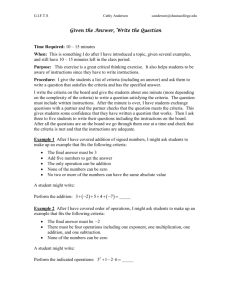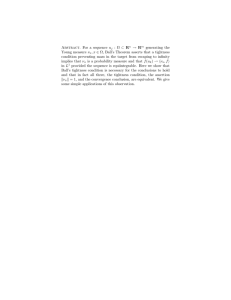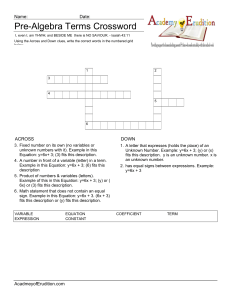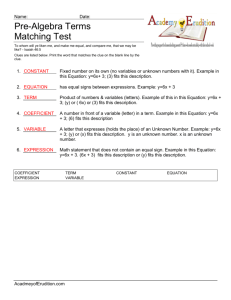1. The table below contains information on 23 (out... (On one flight, the solid rocket motors were lost at... Stat 511 HW#10 Spring 2004 (Not to be Collected)
advertisement
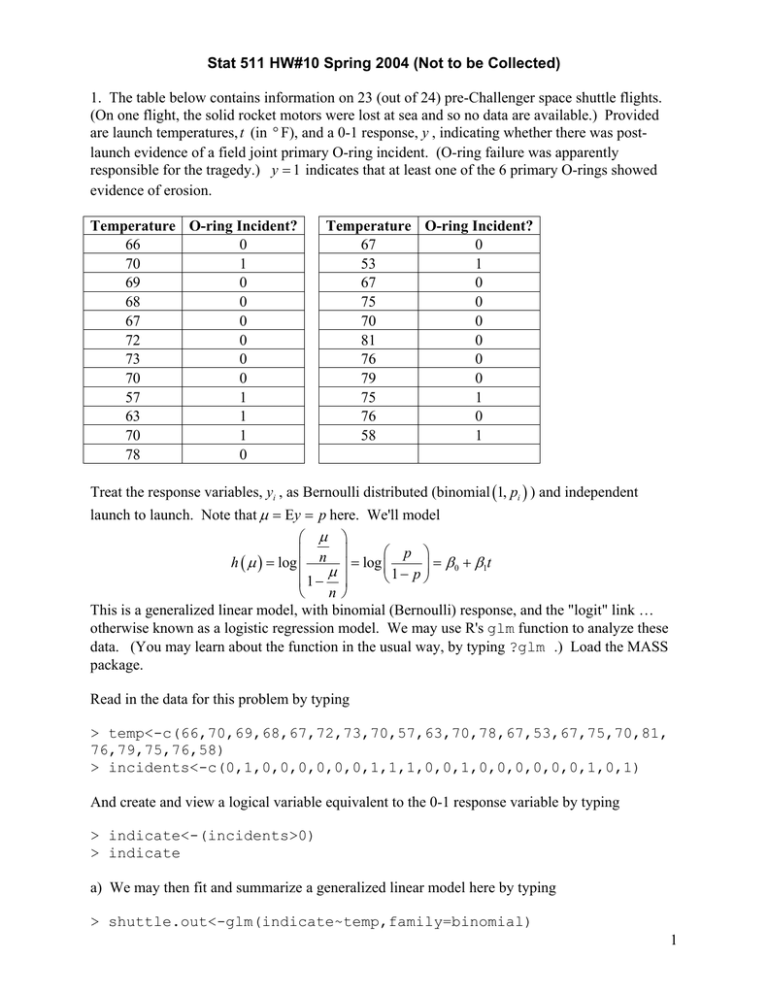
Stat 511 HW#10 Spring 2004 (Not to be Collected) 1. The table below contains information on 23 (out of 24) pre-Challenger space shuttle flights. (On one flight, the solid rocket motors were lost at sea and so no data are available.) Provided are launch temperatures, t (in ° F), and a 0-1 response, y , indicating whether there was postlaunch evidence of a field joint primary O-ring incident. (O-ring failure was apparently responsible for the tragedy.) y = 1 indicates that at least one of the 6 primary O-rings showed evidence of erosion. Temperature O-ring Incident? 66 0 70 1 69 0 68 0 67 0 72 0 73 0 70 0 57 1 63 1 70 1 78 0 Temperature O-ring Incident? 67 0 53 1 67 0 75 0 70 0 81 0 76 0 79 0 75 1 76 0 58 1 Treat the response variables, yi , as Bernoulli distributed (binomial (1, pi ) ) and independent launch to launch. Note that µ = Ey = p here. We'll model µ p h ( µ ) = log n = log = β 0 + β1t µ 1− p 1− n This is a generalized linear model, with binomial (Bernoulli) response, and the "logit" link … otherwise known as a logistic regression model. We may use R's glm function to analyze these data. (You may learn about the function in the usual way, by typing ?glm .) Load the MASS package. Read in the data for this problem by typing > temp<-c(66,70,69,68,67,72,73,70,57,63,70,78,67,53,67,75,70,81, 76,79,75,76,58) > incidents<-c(0,1,0,0,0,0,0,0,1,1,1,0,0,1,0,0,0,0,0,0,1,0,1) And create and view a logical variable equivalent to the 0-1 response variable by typing > indicate<-(incidents>0) > indicate a) We may then fit and summarize a generalized linear model here by typing > shuttle.out<-glm(indicate~temp,family=binomial) 1 > summary(shuttle.out) The logit is the default link for binomial responses, so we don't need to specify that in the function call. Notice that the case β1 < 0 is the case where low temperature launches are more dangerous than warm day launches. NASA managers ordered the launch after arguing that these and other data data showed no relationship between temperature and O-ring failure. Was their claim correct? Explain. b) glm will provide estimated mean responses (and corresponding standard errors) for values of the explanatory variable(s) in the original data set. To see estimated means n 1 and corresponding standard errors, type µli = l pi = 1 + exp ( − β 0 − β1ti ) > shuttle.fits<-predict.glm(shuttle.out,type="response", se.fit=TRUE) > shuttle.fits$fit > shuttle.fits$se.fit Plot estimated means versus t . Connect those with line segments to get a rough plot of the estimated relationship between t and p . Plot "2 standard error" bands around that response function as a rough indication of the precision with which the relationship between t and p could be known from the pre-Challenger data. The temperature at Cape Canaveral for the last Challenger launch was 31 ° F. Of course, hindsight is always perfect, but what does your analysis here say might have been expected in terms of O-ring performance at that temperature? You can get an estimated 31 ° F mean and corresponding standard error by typing > predict.glm(shuttle.out,data.frame(temp=31),se.fit=TRUE, type="response") 2. An engineering student group worked with the ISU press on a project aimed at reducing jams on a large collating machine. They ran the machine at 3 "Air Pressure" settings and 2 "Bar Tightness" conditions and observed y = the number of machine jams experienced in k seconds of machine run time (Run time does not include the machine "down" time required to fix the jams.) Their results are below. Air Pressure 1 (low) 2 (medium) 3 (high) 1 2 3 Bar Tightness 1 (tight) 1 1 2 (loose) 2 2 y , Jams 27 21 33 15 6 11 k , Run Time 295 416 308 474 540 498 2 Motivated perhaps by a model that says times between jams under a given machine set-up are independent and exponentially distributed, we will consider an analysis of these data based on a model that says the jam counts are independent Poisson variables. For µ = the mean count at air pressure i and bar tightness j suppose that Notice that this says log µij = µ + α i + β j + log kij (*) µij = kij exp ( µ + α i + β j ) (If waiting times between jams are independent exponential random variables, the mean number of jams in a period should be a multiple of the length of the period, hence the multiplication here by kij is completely sensible.) Notice that equation (*) is a special case ( γ = 1 ) of the relationship log µij = µ + α i + β j + γ log kij which is in the form of a generalized linear model with link function h( µ ) = log ( µ ) . As it turns out, glm will fit a relationship like (*) for a Poisson mean that includes an "offset" term ( log kij here). Enter the data for this problem and set things up by typing > > > > > > > A<-c(1,2,3,1,2,3) B<-c(1,1,1,2,2,2) y<-c(27,21,33,15,6,11) k<-c(295,416,308,474,540,498) AA<-as.factor(A) BB<-as.factor(B) options(contrasts=c("contr.sum","contr.sum")) a) Fit and view some summaries for the Poisson generalized linear model (with log link and offset) by typing > collator.out<-glm(y~AA+BB,family=poisson,offset=log(k)) > summary(collator.out) The log link is the default for Poisson observations, so one doesn’t have to specify it in the function call. Does it appear that there are statistically detectable Air Pressure and Bar Tightness effects in these data? Explain. If one wants small numbers of jams, which levels of Air Pressure and Bar Tightness does one want? b) Notice that estimated "per second jam rates" are given by exp ( µ + α i + β j ) Give estimates of all 6 of these rates based on the fitted model. c) One can get R to find estimated means corresponding to the 6 combinations of Air Pressure and Bar Tightness for the corresponding values of k . This can either be done on the scale of the observations or on the log scale. To see these first of these, type > collator.fits<-predict.glm(collator.out,type="response", se.fit=TRUE) > collator.fits$fit > collator.fits$se 3 How are the "fitted values" related to your values from b)? To see estimated/fitted log means and standard errors for those, type > lcollator.fits<-predict.glm(collator.out,se.fit=TRUE) > lcollator.fits$fit > lcollator.fits$se 3. Do Problem 2 of the Spring 2003 Stat 511 Final Exam. 4
